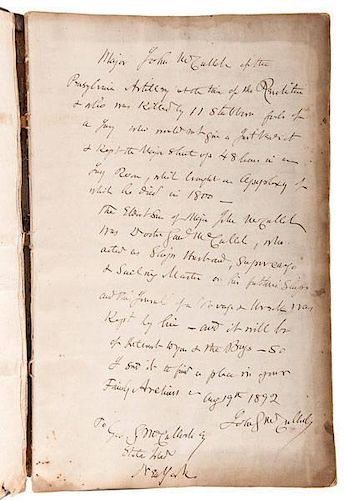Log for the Ship "Washington," 1795
About Seller
6270 Este Ave.
Cincinnati , OH 45232
United States
With offices in Cincinnati, Cleveland and Denver, Cowan’s holds over 40 auctions each year, with annual sales exceeding $16M. We reach buyers around the globe, and take pride in our reputation for integrity, customer service and great results. A full-service house, Cowan’s Auctions specializes in Am...Read more
Two ways to bid:
- Leave a max absentee bid and the platform will bid on your behalf up to your maximum bid during the live auction.
- Bid live during the auction and your bids will be submitted real-time to the auctioneer.
Bid Increments
| Price | Bid Increment |
|---|---|
| $0 | $25 |
| $500 | $50 |
| $1,000 | $100 |
| $2,000 | $250 |
| $5,000 | $500 |
| $10,000 | $1,000 |
| $20,000 | $2,500 |
| $50,000 | $5,000 |
| $100,000 | $10,000 |
About Auction
Nov 21, 2014 - Nov 22, 2014
Cowan's Auctions dawnie@cowans.com
- Lot Description
Log for the Ship Washington, 1795
Approx. 9.5 x 15 in. blank journal (i.e., only lined pages), red leather with embossed border on covers (may have been gilt when made). As with many blank journals, there are two sections, one beginning from each cover. This is one of the earliest ship's logs we have encountered, and it relates to a merchant vessel, from the earliest days of our nation as an independent force in commerce.
From one direction, the first free endpaper includes a manuscript note:
Major John McCulloch of the Pensylvania [sic] Artillery at the time of the Revolution & who was killed by 11 stubborn fools of a jury who would not give a just verdict & kept the Major shut up 48 hours in a jury room, which brought on Apoplexy of which he died in 1800. ----
The eldest son of Major John McCulloch was Doctor Saml. McCulloch, who acted as ships steward, supercargo & sailing master on his father’s ship and this journal of a Voyage & Wreck was kept by him --- and it will be of interest to you & the boys – so I send it to find a place in your Family Archives --- Aug 19th 1892
John S. McCulloch
To Geo. S. McCulloch Esq.
Staten Island
New York
[Note: the "supercargo" was hired by the owner of the cargo to manage it, and, in fact, was the second most important person on the ship after the captain.]
After this is a section titled Rules for finding the longitude / Methods on the first two pages, followed by 45 observations for the ship Washington between 10 July 1795 and 15 June 1796. The next section bears the title Method of solving a Lunar Observation by a New and simple Projection, and five pages with 4 examples, each with a diagram of the geometry behind the method.
The second part - turning the journal upside-down - has another manuscript title page: Journal of a Voyage in the Ship Washington by Sam'l. McCulloch 1796. The first two pages contain a list of the crew for the journey to Calcutta and back to New York. There are 46 men listed. Among these are 16 specialists - commander, surgeon, cooper, carpenter, sailmaker, supercargo, ship's steward, cabin steward, cabin cook, ship's cook, first, second and third mates, etc. There are 17 seamen, 5 "ordinary seamen," seven "boys," and one "cabbin [sic] boy."
The section after this is Measurements of ship - Hull, masts & yards. One note indicates that she is 540 1/2 tons. The following page is Lengths & Sizes of the Running Rigging. We have not seen these in logs previously, but the advantage for constructing replacements if lost in a storm, etc. is obvious.
The next part references the Code of Signals taken from Capt. Samuel Hubbart's journal...in Company with the China Fleet / Received from Sir Erasmus Gorver, Knt. [Knight], Commander of the Lion, Man of War, 1794. This is followed by colorful drawings of signal flags and their meanings.
The last section is the actual log of the journey - 138 days out of Calcutta, headed for Hamburgh, two days per page, from 2 Feb. 1796 to 18 June 1796, when she wrecked at Mount's Bay off Land's End, Cornwall (Mount's Bay is on the English Channel coast of Cornwall, on the eastern side of Land's End peninsula).
Most of the journal is fairly routine, giving the typical weather, setting or reefing (shortening) of sails, repairs made, latitude and longitude, etc. One day they found two barrels of beef spoiled and had to throw them overboard. Occasionally, there is an inventory of water (at one point enough for 110 days).
On 29 March: Joseph Gonsalvus received one dozen & a half lashes from the Boatswain, agreeable to the order of the Captain. All hands were mustered on the Quarter deck to witness the Punishment. The culprit has for some time past been discovered to be frequently intoxicated, having no other means of acquiring liquor, but by embezelment. He was this day caught with half a Gallon of Rum, which he stole in the night.
17 April, “Lying at St. Helena.” …At 4 PM Capt. Hubbart, Mr. D’Arcy, Mr. Farmer & myself went on shore. We found lying here the London Capt. Grant, the Princess Emelia Capt. Millett & the Barwell Cpt. Welladvice(?), British Indiamen from Bombay, and the Eliza Ann Capt Loyd [Lloyd?] from Calcutta. We are informed that the Cleopatra Capt. Dikey sailed from this on the 8th Inst. & the Major Pinkney on the 13th Inst. …
They brought more water on board and made a few repairs. They unmoored at 8AM on 20 April and got ready to sail. Also Brought on more food, including a bullock, potatoes and fruit. Mr. Farmer procured a new servant maid from the islands and left his other behind, since she had been confined for three weeks with Typhus.
On the 25th of April, they reached Ascension Island, and Hubbart, D’Arcy, Grant and he went on shore. Next night, they and 20 men, in groups of 5, went on shore to spend the night catching turtles. About the 3rd of May a number of the officers became very ill. He describes the symptoms in clinical detail. I impute it all to the Turtle diet. Two days later, Two of our Turtles died last night.
A number of times he refers to the luminosity of the seas at night. [7 May] Seas appeared uncommonly luminous which continued until day light. This Phenomenon I believe has never yet been satisfactorily accounted for. Capt. Cook, if I recollect right, supposes it owing to animalcula in the water possessing the same power of showing light that the light[ning] bug does. If this was the case ought we not to see it more frequently? I am rather of an opinion however, that it is owing to the Commintures of the rain water with the Salt. Having had a great deal of rain some days past, renders this conjecture somewhat probable.
On 17 May, they encountered a fleet of 21 ships. One stood toward them in the early afternoon (i.e., aimed the guns on that side in their direction). A boat was sent out. She proved to be the Quebec, British Frigate, Capt. Cook ...Rear Admiral Pool with a Convoy of 21 Sail of Transports & Gun boats with 10,000 soldiers on board bound to Barbadoes & out 5 weeks. About three weeks later they encountered another ship who appeared to be chasing them…[B]ut it blowing fresh with a rough Seas & he having shown no colors, the Captain did not think it proper to shorten sail for her. At noon she was nearly out of sight astern.
Then came that fateful day, 18 June: At ½ past 5 PM saw several fishing boats standing out of Mount’s Bay. At 6 PM shortened Sail & took a Pilot on board from one of them who agreed to carry the Ship into Falmouth for 10 Guineas, made all possible sail again upon the Course ordered by the Pilot as I log. At 8 PM the weather became very thick & hazy again. At 9 PM I thought I heard the surf break on the shore, which I immediately remarked to the Pilot. He said that we were nearly up with the Lizard, ordered all the light sails in, to brace the Yards sharp & haul to the Southward, but immediately discovered one of the Stag Rocks close upon our larboard bow, having the Flood tide with us, & considerable way on the Ship, we soon found ourselves completely surrounded with rocks. Hove alls aback & endeavored to get the Ship out from among them, but our efforts were ineffectual, for the tide having as much command of her that she was in a few minutes driven on the Rocks without a possibility of getting her off again.
He goes on to describe the efforts to save her – firing a distress signal with the guns, cutting away the long boats, manning the pumps, etc. Meanwhile, Upon the first observing the Rocks the Pilot appeared in the greatest confusion & acted with much inconsistency. He made his escape in one of the country boats, in the morning, unobserved by any of our Crew. They began shuttling off the cargo, and anything else useful (even sails) to shore and leaving men to guard it.
Toward the end, he notes: The Ship was totally lost but the cargo principally saved, thro’ the exertion of the Crew & the assistance procured by Mssr. G.C. For(?) Jones.Boards loose from one direction, but still intact. Usual wrinkling and toning from humidity and age. Still very readable, no major damage to text itself.Condition
- Shipping Info
-
SHIPPING. At the request of the buyer, Cowan's will authorize the shipment of purchased items. Shipments usually occur within two weeks after payment has been received. Shipment is generally made via UPS Ground service. Unless buyer gives special instructions, the shipping method shall be at the sole discretion of Cowan's Auctions, Inc.. Cowan's is in no way responsible for the acts or omissions of independent handlers, packers or shippers of purchased items or for any loss, damage or delay from the packing or shipping of any property.
-
- Buyer's Premium



 EUR
EUR CAD
CAD AUD
AUD GBP
GBP MXN
MXN HKD
HKD CNY
CNY MYR
MYR SEK
SEK SGD
SGD CHF
CHF THB
THB










